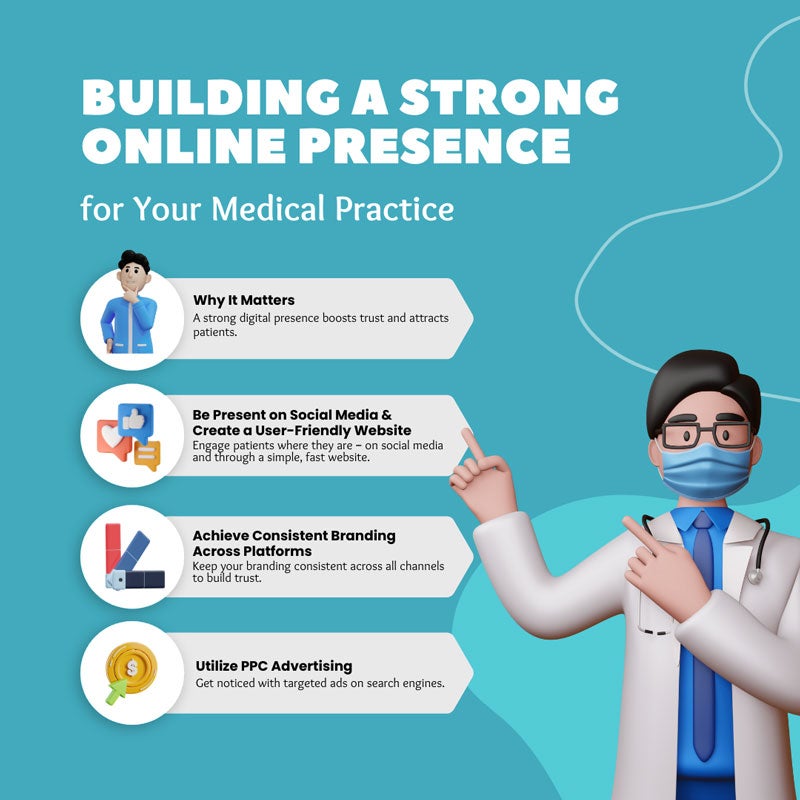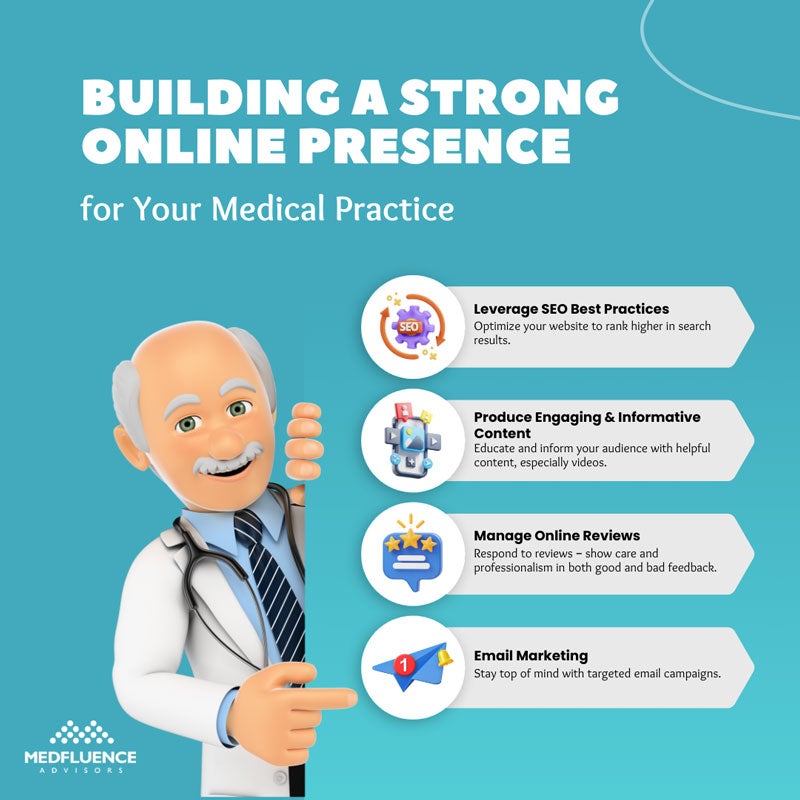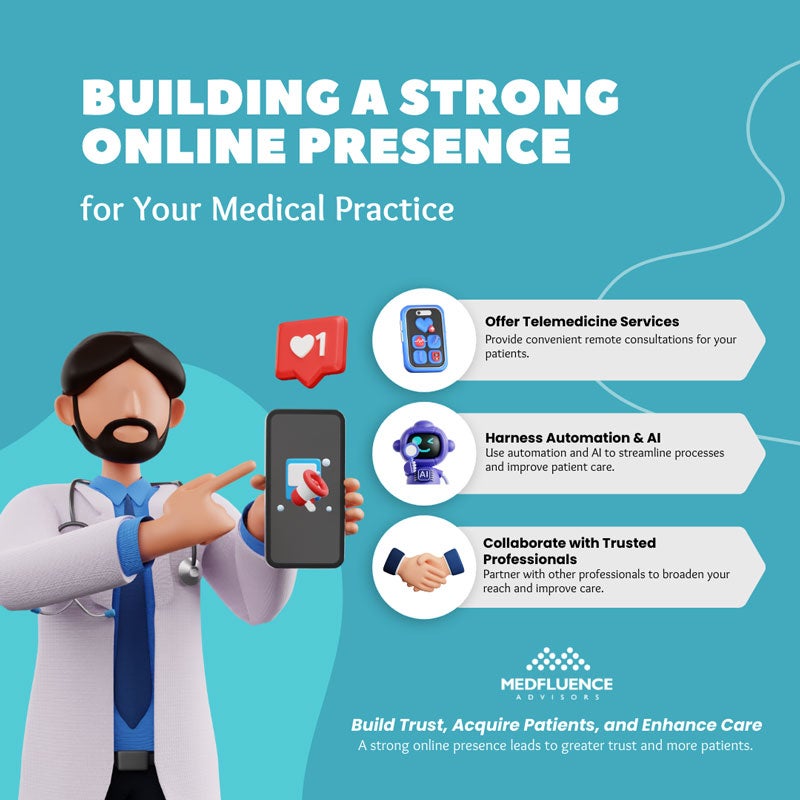Digital Footprint: Maximizing Patient Acquisition

The healthcare sector has fully embraced the digital age. It all started when a global pandemic hit and rendered the world crippled. It took a toll on all industries but especially on the healthcare sector which was in the middle of everything.
To accommodate the healthcare needs of millions of patients worldwide, the healthcare industry has turned digital. This allows medical professionals to consult with their patients remotely, providing efficient medical advice and treatments without having them come to physical care facilities.
Today, even as things have gone back to normal and patients can freely walk in and out of hospitals and clinics for their healthcare needs, a practice’s digital presence is more important than ever.
Traditionally, patients choose their healthcare providers based on word-of-mouth recommendations and physical marketing materials. In today’s digital age, however, patients turn to the internet and social media to look up information on healthcare providers and make informed decisions based on their research.
In a competitive and saturated marketplace like healthcare, it’s more crucial than ever to stand out; your practice can achieve that by recognizing the power of the digital footprint and using it as leverage to attract more people into choosing your practice over your competitors.
What Is a Digital Footprint?
A digital footprint refers to a person’s, business’s, or organization’s traceable digital activities on the internet and digital devices. This encompasses one’s digital information as a result of all their online activities – this includes everything they do online from social media to articles they read.
Digital footprint applies to both private people and businesses like those operating in the healthcare industry. For businesses and professionals, your digital footprint is your digital professional persona. When potential patients look up information about your practice, what they see online will affect their decisions.
The Importance of Digital Footprint to Healthcare Professionals
Curating and enhancing your digital footprint as a healthcare professional is a crucial part of doing healthcare marketing that helps your practice grow. Here are the reasons why you should pay close attention to your practice’s digital footprint:
Increase online visibility
The healthcare sector is experiencing a significant shift to online platforms – it’s where potential patients and audiences are. Curating a well-crafted digital footprint will set your practice apart from your many competitors. Stand out from the crowd and show what your practice can offer to patients experiencing various health issues.
Build an accessible online presence
Digital platforms are an efficient place where care providers can connect with their patients. The digital space provides an accessible avenue for patients to reach out to their care providers with questions they might have regarding their health. It also provides the perfect platform for healthcare providers to make healthcare information widely accessible to a wide variety of audiences.
Enhance trust and credibility
In healthcare, trust and credibility are paramount to a successful medical practice. Working towards increasing your practice’s online visibility and accessibility to a wide range of audience will help establish trust with patients, colleagues, and industry leaders. Through a carefully curated online presence, healthcare professionals can share valuable healthcare information that showcases their expertise in the field. When patients see that your practice is knowledgeable, they are more likely to choose your practice over your competitors and trust your services.
The Healthcare Sector in the Digital Realm
In today’s increasingly digital landscape, patients are more inclined to turn to the internet to look up healthcare information and services. This is a massive shift from the traditional word-of-mouth recommendations and old-school advertising and marketing efforts most people used to see when they stepped out of their homes. While these may still work, they’re no longer the priority.
Today, people bring out their phones or hop on their computers and look up the information they need. Information is quite literally at their fingertips.
Having a strong online presence is more crucial than ever if you want your practice to stay competitive. Your audience and potential patients also expect your practice to be online and streamline processes by going digital. If your practice doesn’t meet this expectation, then they will look for a different practice that meets their digital needs.
If you want your audience to keep your practice at the top of their minds should a need arise, ensure that you have a positive presence in the digital realm – after all, it is where most of your audience is.
What Is Patient Acquisition?
As more and more of your target audience spends their time online, your practice can take a proactive approach and use this as leverage to reach more people and acquire more patients.
In the context of healthcare, patient acquisition involves a set of strategies and techniques to attract people into choosing your practice should they need a medical service that you offer. The process of acquiring patients includes identifying your target audience, engaging them in a conversation or connection, and converting them into loyal customers.
Acquiring patients is more than just convincing them to choose your practice. It’s about building a connection, starting meaningful conversations, building trust, ensuring your practice follows through with quality care, and ensuring patient satisfaction and positive patient outcomes. All these accumulate to build patient loyalty, increasing your practice’s patient retention rates.
Remember, patient acquisition and retention are both critical keys to business success.
The Importance of Patient Acquisition
Patient acquisition plays an important role in the success (or failure) of a medical business. It’s an indispensable aspect of your private practice for these reasons:
Support patient growth, revenue influx, financial stability, and long-term business growth
The influx of new patients into your practice supports increased revenue, business stability, and long-term business growth. Attracting new patients will benefit your medical practice business in the long run. This also supports further investments and advancements in your practice, allowing for more efficient patient care.
Broaden online and local reach
Attracting new patients into choosing your practice over your competitors widens your online and local reach. In the digital world, satisfied patients are more likely to leave positive reviews and talk about their positive experiences with your practice. People who rely on online searches can see this and positively consider choosing your practice.
While traditional word-of-mouth marketing is taking a step back, recommendations from trusted individuals still weigh on a patient’s decision-making processes. Attracting new patients into your practice and ensuring they leave with a positive experience will encourage them to recommend your practice to other members of your local community.
Stay competitive
The healthcare industry is saturated with competitors. There is a lot of noise vying for the attention and interest of the same audiences. Implementing appropriate and efficient strategies to attract new patients ensures your competitive advantage.

How Digital Footprint Drives Patient Acquisition
Build a strong online presence
A powerful online presence creates a positive digital footprint for your practice. This amplifies your marketing and patient acquisition efforts. You can build connections and start meaningful conversations with your target audience – and with the right push, you can convert them into patients.
Be present on social media and create a user-friendly website
Today’s modern patients are more online than ever. You can drive patient acquisition rates by ensuring you have a strong presence on social media. Be present where your audience is. Popular social media platforms where most of your audience hangs out include Facebook, X (formerly Twitter), Instagram, and TikTok.
Additionally, creating a user-friendly website will further cement your practice’s positive online presence in the digital realm. A user-friendly website should be simple, easy on the eyes, easy to navigate, functional, and speedy. Consider adding an online appointment scheduling feature to make it easy for potential patients to convert.
Achieve consistent branding across platforms
Part of curating a positive digital footprint is ensuring that your practice has consistent branding across multiple platforms. If you are present on multiple platforms and business listing websites, make sure you have consistent branding, colors, visuals, and messaging. Consistent business information like the business name, operating hours, and contact information is also crucial. This will not only look professional but will also help build patient trust and credibility.
Get your hands on PPC advertising
PPC (pay-per-click) advertising is an effective strategy to get your practice in front of potential patients. PPC ads appear on search engine result pages, alongside organic results. This means your ads are targeting people who search for medical information or healthcare services which could increase traffic to your website.
Focus on leveraging SEO best practices
SEO (search engine optimization) is a set of strategies that helps improve your practice’s visibility online. This strategy involves refining and tailoring your website content and structure to meet potential medical queries and search results. Keyword research is an integral part of SEO as this drives traffic to relevant websites according to the user’s query and search intent.
Produce engaging and informative content
Thousands of health-related queries take place on the internet every day. People are actively looking for credible sources for all their questions, especially if it has something to do with their health.
Build a positive digital footprint for your practice by producing not only engaging but also informative content. Produce content that is backed by facts and science. Inform, educate, and empower your audience with the needed information to help them make the appropriate decisions for their health.
Video content is increasingly becoming an in-demand form of healthcare content. It provides a dynamic way to communicate, educate, and inform in an engaging and entertaining way. Additionally, keep your audience engaged and interested with fresh content you regularly post on your website and social media accounts.
Don’t neglect online reviews – both positive and negative
Online reputation is a crucial part of your practice’s digital footprint. Your patients can freely share their experiences with your practice online. Online reviews are one of the first things potential patients see when they look up your practice, directly impacting their decisions if they will move forward with your practice or not.
As the healthcare industry makes big shifts toward the digital realm, you should know by now that you shouldn’t leave online reviews up to chance. Practices and businesses must proactively manage them.
Always acknowledge and express gratitude for positive reviews. Additionally, address negative feedback as well – never ignore them. Address them with professionalism and swiftly resolve patient concerns. This shows your audience that you care and have a commitment to ensure patient satisfaction.
Email marketing works too if done right
Email can be an effective marketing strategy if done right. Using email lists and newsletters can help your practice target patient groups. This ensures they constantly remember your practice and should a need for a medical service arise, you are at the top of their minds.
Healthcare practices can also use email marketing via automated appointment reminders and follow-ups, keeping patients consistently engaged throughout their patient journey.

Telemedicine widens your reach further
Telemedicine became the norm during the peak of the COVID-19 pandemic when care providers could not see their patients in person for consults. Today, telemedicine continues to be an appealing feature for many patients who wish to remotely consult with their doctors.
Offering telemedicine services will help your practice stand out from your competitors. The convenience of remote consultations will be highly appreciated by your current clientele but can also open up opportunities to attract new audiences into choosing your practice.
Automation and AI are your friends
Automation and AI can provide transformative benefits for medical practices. It can streamline processes and increase convenience for both medical workers and patients. Automation systems can also aid in data management which can take a lot off of your staff’s plate, giving them more time to focus on patient-facing tasks.
AI applications in the healthcare sector can enhance patient care, increase patient satisfaction, and attract more patients to choose your practice for their needs.
Collaborate with other trusted professionals
Forming strategic collaborations and partnerships with other trusted professionals can unlock new opportunities to attract and acquire new patients and clientele into your practice. Collaborations and partnerships give your practice access to a wider patient base and professional network.
Additionally, uniting healthcare professionals in your local community enhances the quality of patient care. Coordinated healthcare efforts streamline patient experience and enhance patient outcomes.

An Integral Part: Protecting Private and Sensitive Patient Information
In your efforts to curate your practice’s digital footprint, may you never forget the most important aspect of it all: protecting your patient’s private and sensitive information.
In every aspect of healthcare marketing, security and patient privacy should be prioritized and at the center of your decision-making – especially now in today’s digital age. Ensure that your marketing efforts are in line and compliant with HIPAA. Compliance with laws and regulations is more than just about legality, it’s about building trust.
Ensuring the protection of private and sensitive patient information and utilizing encrypted communication platforms will go a long way in healthcare service. When your audience feels that their information is safe with your practice, the more likely they are to choose your services.
Embrace the Digitization of Healthcare
Today’s healthcare landscape is making significant and unique shifts towards the digital realm. There’s no stopping it – and healthcare systems must make necessary changes to ensure they are not left behind.
Your digital footprint reflects who you are in the digital world – and if managed right, it can be a vital part to attracting new patients, fostering patient loyalty, positioning yourself as a healthcare leader in your community, and supporting business growth and success.
Healthcare practices must not deny the power of digital presence, but instead embrace the digitization of healthcare and leverage it to thrive in such a saturated marketplace.


